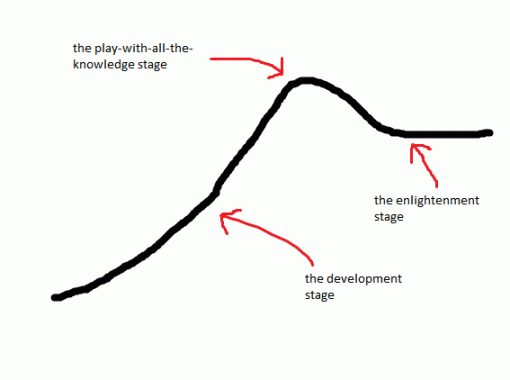It’s great not to have to source everything I’m writing. For the past year or so I’ve had my head down working on my TESOL MA. This could be used as an excuse for not having written a post for so long, but it’s probably down to human distraction/laziness/being-busy-with-other-projects. Nonetheless, here’s the new post.
Let’s talk about the Beatles. Arguably one of the greatest bands in modern (non-classical) history? I’ve been into them since I was a kid and have met very few people who don’t like them – or at least who don’t like some of their stuff. They had an insane effect on the shape of modern music and on top of all that, were seriously nice chaps. (I promise this will come round to the English teaching world – just bear with me).
The Beatles went through various shapes and guises and managed to go from looking like this:

to this:
 and then this:
and then this:

Their music, too, also went through a similar process of change, each more or less reflecting the three images above. They started out all clean and squeaky – singing about love and being nice, sincere lads. The albums over this period shot them to “bigger-than-Jesus” fame among screaming 14-year-old boys and (mostly) girls from shore to shore. The music was simple, 3 or 4 chord stuff and centred on themes of love, holding hands, missing loved ones, and more love. (Notable albums from this period: Please Please Me, Twist and Shout, A Hard Day’s Night, Help!).
Then they got weird (see second photo). It might’ve been hanging around with Maharishi Mahesh Yogi, or perhaps it was just the drugs. But they went on to write some of the material that would cement their place in music history – taking a new psychedelic turn that brought in a lot of complexity to their sound that was almost completely unknown in mainstream music at the time. Not only did they start expanding the range of chord sequences and the like within songs, but seriously started messing around with samples – and genuinely experimenting. It was, to use a cliche, a higher plane. (Notable albums from this period: Sgt. Pepper’s Lonely Hearts Club Band, Magical Mystery Tour, The White Album).
Finally, as the band was starting to fall apart (let’s not all blame Yoko here, please… such an easy scapegoat), the music took on a more somber, mature tone. They were growing up and the music reflected that. In doing so, it took on many of the elements of the early stuff – not just the simplicity, earnestness, and a lack of pretention, but also the uncomplex chord/song structures. This time however, with a wiser and better-informed* bent. They had pushed the limits of the sum of their parts to an extreme, and come back from it with a better understanding of expressing themselves. (Notable albums from this period: both of them – Abbey Road and Let it Be).
Musically speaking, the journey The Beatles took throughout their decade-long career went from a simple-building-up-of-complexity stage (let’s call that the development stage), to an (over)-elaborate doing-everything-at-once stage (let’s call this one the play-with-all-the-knowledge stage), to a mature, controlled, enlightened-by-the-previous-two-stages** stage (the slightly less-preposterously-titled enlightenment stage). If it were a graph – I guess it would look like this:
OK. Now let’s talk about English learners’ development.
I’m not going to start at the beginning here, but somewhere in the middle. Have your students ever come up with sentences like this?:
“I graduated from the department of physics of the University of Marmara.”
or
“The friend of my cousin had turned back to London and came to my home.”
or
“Because of there is too much work, I don’t have time to enjoy leisure activities.”
I come across sentences like this regularly. These sentences all sound wrong for some reason, but most people, if asked, would find it difficult to pin down the problem: there appear to be no actual errors or mistakes in grammatical terms and the vocabulary itself all makes sense. Often when sentences ‘feel’ wrong, it’s down to a word being used when a more approrpriate synonym should be used instead, like “do a speech” instead of “make a speech”. But again, this doesn’t cure this conundrum. To me, what’s happening here is an overuse of language skills. The student has reached a particularly high level of language competence and might feel that the more complex a sentence is, then the better their English is going to be perceived. Fixing these sentences in order to make them sound more natural would actually require a sort of ‘downgrading’ of the language:
“I graduated in Physics from Marmara University.”
“My cousin’s friend went back to London and came to mine.”
“Because there’s too much work, I don’t have time to enjoy myself.”
I want to point out that in order for this post to work, I’m about to make some rather broad generalisations. It’s intended only as food for thought rather than an all-encompassing perspective on language learner development….
… but I have noticed this trend among students within my own teaching context on a regular basis. I’ve also seen such over-elaborate use of English in places and from people who should know better: plaques describing various tourist attractions in the city (soooo much use of past perfect), and academics almost arrogantly showcasing their modal-ridden robot-English, and unable to have a normal conversation as everything appears to get lost in a fog of dangling modifiers and, again, an obsession with the past perfect.
It’s at this stage, when the learner has a respectful level of competence and confidence with the language, that they start experimenting with their acquired knowledge. I suspect that this is a necessary stage of that long journey to near-native levels of English (no citations – but any comments on this notion would be welcome). It’s like that classic saying art teachers always seem to be telling their teenage students who just want to paint cubes for their course work: “In order to break the rules, you have to learn them first”.
I’ve seen people get stuck in this stage, having conversations about relatively inane topics such as their favourite bands, or what was on TV last night, but sounding like some sort of mad legal document. To me, the final stage of the learning process (is there such a thing?) is to sort of deprogram a lot of what they have learned. Using that impressive level of acquisition and honing it in, streamlining it, humanising it, or downgrading it. The English that emerges from this process, in the cases I’ve seen, leads to a beautifully expressed, unpretentious, and mature use of the language.
To recap: we’ve got the general acquisition process (not mentioned here, but plenty on the web discussing it), which we could call the “development stage”, the point where overcomplexity comes into the picture, the “play-with-all-the-knowledge” stage, and the streamlining process leading to what we could call the “enlightenment stage”. I suppose if it were a graph, it’d look like this:
As I mentioned above – this is clearly a massive generalisation. Native speakers themselves continue learning their own language as they go through life, so L2 learners are no exception. But there does appear to be this interesting point somewhere when overcomplexity kicks in and the next place to go is down.
Also – the Beatles were great.
* This is the second compound adjective in this article. By no means will it be the last. You’ve been warned.
** Told you.















